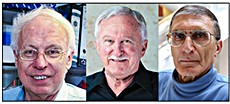Tomas Lindahl, Paul Modrich, Aziz Sancar share chemistry Nobel
08 Oct 2015
The Royal Swedish Academy of Sciences has decided to award the Nobel Prize in Chemistry for 2015 jointly to Tomas Lindahl, Paul Modrich and Aziz Sancar "for mechanistic studies of DNA repair". The prize amount of 8 million Swedish krona (about $960,000) will be shared equally among the three the laureates, the academy said.
 Tomas Lindahl is with the Francis Crick Institute and Clare Hall Laboratory at Hertfordshire, UK while Paul Modrich teaches at Howard Hughes Medical Institute and Duke University School of Medicine, Durham, NC, USA and Aziz Sancar is associated with the University of North Carolina, Chapel Hill, NC, USA.
Tomas Lindahl is with the Francis Crick Institute and Clare Hall Laboratory at Hertfordshire, UK while Paul Modrich teaches at Howard Hughes Medical Institute and Duke University School of Medicine, Durham, NC, USA and Aziz Sancar is associated with the University of North Carolina, Chapel Hill, NC, USA.
The Nobel Prize in Chemistry 2015 is awarded to Tomas Lindahl, Paul Modrich and Aziz Sancar for having mapped, at a molecular level, how cells repair damaged DNA and safeguard the genetic information.
Their work has provided fundamental knowledge of how a living cell functions and is, for instance, used for the development of new cancer treatments, the Nobel Prize committee said.
Human DNA is damaged almost every day by UV radiation, free radicals and other carcinogenic substances, and even without such external attacks as a DNA molecule is inherently unstable. Defects can also arise when DNA is copied during cell division, a process that occurs several million times every day in the human body.
However, the changes to the genetic material does not disintegrate into complete chemical chaos as a host of molecular systems continuously monitor and repair DNA, the researchers found.
''The Nobel Prize in Chemistry 2015 awards three pioneering scientists who have mapped how several of these repair systems function at a detailed molecular level.''
In the early 1970s, scientists believed that DNA was an extremely stable molecule, but Tomas Lindahl demonstrated that DNA decays at a rate that ought to have made the development of life on Earth impossible.
This insight led him to discover a molecular machinery, base excision repair, which constantly counteracts the collapse of our DNA.
Aziz Sancar has mapped nucleotide excision repair, the mechanism that cells use to repair UV damage to DNA.
People born with defects in this repair system will develop skin cancer if they are exposed to sunlight. The cell also utilises nucleotide excision repair to correct defects caused by mutagenic substances, among other things.
Paul Modrich has demonstrated how the cell corrects errors that occur when DNA is replicated during cell division. This mechanism, mismatch repair, reduces the error frequency during DNA replication by about a thousandfold. Congenital defects in mismatch repair are known, for example, to cause a hereditary variant of colon cancer.
The Nobel Laureates in Chemistry 2015 have provided fundamental insights into how cells function, knowledge that can be used, for instance, in the development of new cancer treatments.






























